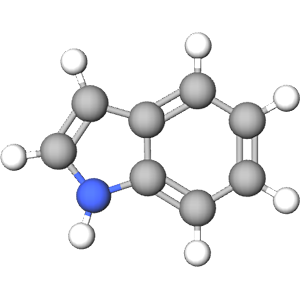

Indole is a naturally occurring compound with a complex scent profile that can be described as a mix of floral, mothball-like, and slightly fecal notes. It is found in the scent of many flowers, such as jasmine and orange blossom, contributing to their characteristic fragrances.
Predominantly used in the creation of floral scents, adding richness and intensity to perfume compositions. Its distinctive aroma makes it a key ingredient in replicating the natural scents of white flowers.
IUPAC Name: 1H-indoleCAS Number: 120-72-9
Molecular Formula: C8H7N
Molecular Weight: 117.15 g/mol
Boiling Point: 128-133 °C @ 28 mm Hg (253 °F)
Melting Point: 52.5 °C (126.5 °F)
Class: Indole
Use/s: Scent
Synonyms
1: indole 2: 1H-Indole 3: 2,3-Benzopyrrole 4: Indol 5: 1-Benzazole 6: Ketole 7: 1-Azaindene 8: Benzopyrrole 9: 2,3-Benzopyrole
Chemist Says
White to yellowish solid with an unpleasant odor; Pleasant odor in dilute solutions; Turns red when exposed to light or air; [Hawley] White or yellow crystalline powder; [MSDSonline]
Scent: Unpleasant, Floral
Scent profile
Scent profiles are inherently subjective and can significantly differ among individuals, and may also be influenced by the conditions at the time of evaluation. The information provided here is a synthesis of data from diverse sources, including books, cross-references, artificial intelligence analyses, and chemical research sites, aiming to present a comprehensive overview. We've distilled this information to highlight the most frequently observed scent profiles for each molecule or compound, offering a generalized perspective.
1: Floral, Animalic, Heavy, Intense
2: Floral, Jasmine, Musty
3: ALMOST FLORAL ODOR WHEN HIGHLY PURIFIED, OTHERWISE EXHIBITS CHARACTERISTIC ODOR OF FECES
4: Fecal, floral (in high concentrations)
 Corrosive
Corrosive Acute Toxic
Acute Toxic Irritant
Irritant